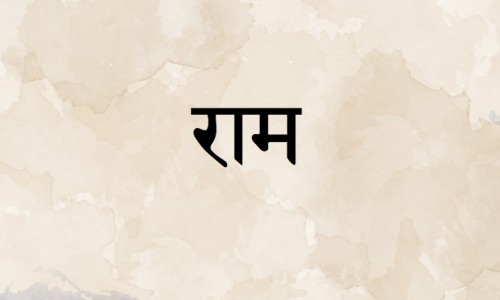From temple to temple, the same forms of God can be found but they often vary slightly in appearance. The sculptors carve these forms in their own style, which accounts for any dissimilarity. However, it must be noted that the names associated with these forms do not change. The name ‘Shiva’ remains the same, even when there are differences in appearance from murti to murti. Similarly, the name ‘Vishnu’ remains ‘Vishnu’, and so it is with all the names of God through the ages. Indeed, the names of God are mahaa mantras (great sacred chants of deliverance).
The name of God is superior to the form
Evidence of this statement can be found in scriptures where instances of repetition of the name brought enlightenment, freedom from struggles and salvation to many devotees. In Shri Raamcharitramaanas, author Tulsidas narrated many incidents where devotees were liberated by the form of Shri Raam Himself, and countless others, by the mere chanting of His name. In Shiva Puraana it is recorded that Upamanyu, a five-year-old child was granted the darshan (appearance) of Lord Shiva by continuous repetition of the Panchakshara Mantra (Om Namah Shivaya) that his mother taught him. Child devotees, Dhruva and Prahalad, also came face to face with the Divine through the mere repetition of His name.
The Power behind the Names of the Divine
The question may be asked, what kind of power lies behind the names of the Divine, these mahaa mantras? A breakdown of the word, mantra, may provide an answer. Mantra is comprised of ‘man’, meaning ‘mind’, and ‘tra’- meaning ‘an instrument or tool’. A mantra then is an instrument of thought.
The names of the various deities are in Sanskrit. Each letter relates to a particular chakra or energy centre in the body. By reciting the name, different energy centres are activated and the energy flows through the 72,000 nadis or channels that crisscross the subtle body. This awakens the inner force or shakti that enables greater awareness of one’s true nature. One may not be aware of these subtle, inner transformations but the results are evident. Ratnakar was unaware that he was repeating the name, ‘Raam’, yet he was transformed to Sage Valmiki, or Adikavi, foremost of poets. Countless persons have been saved from untimely death by chanting the Mahaa Mrityunjai mantra. This Shiva mantra, like many other potent formulae, has the power to remove all suffering and disease and bestows good health and long life to the one who chants it with devotion. It is also believed that constant contemplation of this mantra can help spiritual aspirants to overcome the cycle of birth and death.
Continuous repetition of the name of God purifies the mind of the one who repeats it and also cleanses the environment where it is chanted. Mantras, when chanted, are like seeds that are sown, watered and fertilized. The more they are repeated with attention, concentration and sincerity, the more effective they become. Mantra repetition or mantra jaap can be performed in various ways. Mantras may be recited aloud, softly or in the mind. Likhit jaap or writing the mantras repeatedly can also be practised.
The Power of the Name ‘Raam’
The name, Raam, is a mahaa mantra. Tulsidas sheds light on the power of each of the letters that comprise this word and extols the glory of the name. The word, ‘Raam’, is comprised of the letters ‘ra’, ‘aa’ and ‘ma’, with each letter representative of a source of light. A brief insight into each of these constituents will give some understanding into the power that is wielded by the repetition of the name ‘Raam’ and consequently, the quality of spiritual perfection that Shri Raam personifies.
1. ‘Ra’ represents agni (fire), which is a source of light on earth. Agni burns away the fruits of one’s actions, both positive and negative. ‘Ra’ is also representative of rakt dhaatu – one of the seven fundamental principles or elements that support the basic structure and functioning of the body. It is the carrier of the fire that invigorates the body and mind. As such, when rakt dhaatu is at its optimal level, a person feels energized with a healthy outlook on life.
2. ‘Aa’ represents Soorya, the sun, a source of light in the heavenly sphere. The sun removes the darkness of ignorance, from which other forms of negative qualities are derived. These are: egoism, attachment, aversion and the fear of death. ‘Aa’ is also one of the letters of the Sanskrit alphabet that signifies aanand shakti, the embodiment of bliss.
3. ‘Ma’- represents Chandramaa, the moon, which signifies the remover of taap (pain). The three main types of pain are daihik, pertaining to bodily discomforts, bhoutik or environmental difficulties and daivik or dealing with natural disasters. The letter ‘Ma’ is also associated with the heart. By chanting the name, ‘Raam’, all pain can be destroyed.
As a tool of transformation, repetition of mantras is most useful in one’s life. It is one of the nine types of devotion outlined by Shri Raam to Shavari in Raaamaayan Kathaa. To schedule the act of mantra-recitation in one’s daily routine is to become engaged in a practice that will sustain, uplift and purify oneself as well as one’s environment. Without doubt, the form of God has inspired many. The name, on the other hand, is a most potent instrument of thought.
It is said that the surest, safest and easiest means of expiating sins in this age is repetition of the name of the Divine. Chant! Chant the name and be happy!




Kilawattee Mohammed
Very informative.